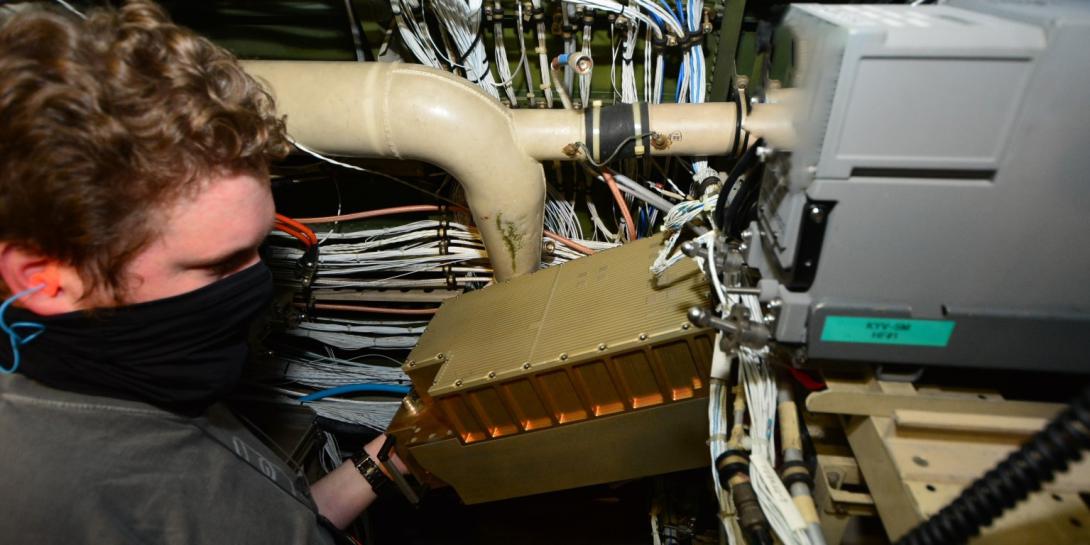U.S. Air Force Pursues Updated Airborne High Frequency Radios
The Air Force Life Cycle Management Center’s Electronic Warfare and Avionics Program Office at Robins Air Force Base, Georgia, will transform legacy airborne high frequency radio systems into assured, anti-jammable radio communications capabilities for a near-peer environment. The effort will modernize high frequency radios across Air Force, Navy, Marine Corps and Coast Guard aircraft under a multiyear contract with BAE Systems, the base stated in a report from Holly Logan-Arrington, Robins Public Affairs.
The office’s Rapid Prototyping and Fielding Program will partially redesign and update an estimated 2,500 radios across the Air Force’s HC-130J, KC-135, C-130H, C-130J, C-17, C-5, B-1, B-52 and E4-B aircraft, as well as the Navy’s E6-B, the Marine Corps’ KC-130J, and the Coast Guard’s C-130 and C-130J aircraft, Logan-Arrington said.
The work will begin with AN/ARC-190, the Air Force’s workhorse, airborne high frequency radio. The capability is ideal for transoceanic flights and long-haul communications without having to rely on satellite communications, and will be strengthened with improvements for contested operations.
“The AN/ARC-190 is still functional, but isn’t capable of meeting today’s warfighter’s needs and is no longer in production,” said Capt. Jeremy Fazely, USAF, program manager, Airborne High Frequency Radio Modernization Program (AHFRM), Electronic Warfare and Avionics Program Office. “If the AHFRM program didn’t exist, the field would start to see degraded operational impacts as early as 2024.”
Capt. Fazely is leading the 35-person multidisciplinary team that will rapidly develop and field a replacement airborne high frequency radio meant for the near-peer environment, Logan-Arrington noted. To meet the program’s schedule, Fazely’s group will reuse some elements of the aircraft’s high frequency radio system while redesigning and modernizing other elements.
“The new radio will perform all the same functions of the legacy radio and also be forward and backward-compatible to ensure that as we field these new radios that operations are not interrupted,” the captain said. “We’re really excited about the new enhanced and assured capabilities this radio will provide the warfighters. The Air Force, Marine Corps and Navy will all gain new secure, long-haul radio capabilities in order to enhance their operational effectiveness.”
The team will completely rebuild the radio’s receiver/transmitter (R/T), “so that it’s a box that will fit in the same profile as the legacy radio, using existing aircraft connections and wiring,” Fazely noted. “The new R/T is a software-defined radio with three expansion slots, making this new R/T easily upgradeable and agile to address future requirements, like adding new waveforms or changing the way the radio transmits voice or data.”
As its lead platform, the team is using the KC-135 and began with prototype testing last summer.
“We’ve been testing the prototypes almost monthly onboard either a KC-135 at various locations or in the C-5 System Integration Lab located at Robins,” he said. “We’ve brought in radio operators to these test efforts and combined that with our integrated working groups with the various aircraft system program offices. We’ve been successful in obtaining early and often human-to-machine interface feedback for the radio’s development.”
This year, the AHFRM will begin developmental testing and will be installing new radios on the KC-135. They will move to operational flight testing, as well as develop a baseline integration guide and low-rate production of assets for the various aircraft’s program offices to use for their integration and test efforts, before fielding begins. Capt. Fazely explained that the various aircraft system program offices will be responsible for coordinating the efforts to install these radios.
“Once the aircraft system program offices test and ensure the new radio’s functionality, maintenance units will begin receiving new radios and instructions for field-level installations via a time compliance technical order,” he said.
By 2027, BAE will complete the rapid fielding phase by producing and installing 2,000 radios on aircraft. The remaining 500 radios will be installed under a traditional federal acquisition regulation-based follow-on contract, according to Logan-Arrington.
The Air Force approved the effort to be a so-called Section 804 Middle Tier of Acquisitions- Rapid Fielding Program, propelling the rapid prototyping of the radio.
“This new radio will be able to give those aircrew an alternate, assured means of communicating should they lose satellite communications, or have to communicate in an area where the communication spectrum is contested by an adversary jamming or spoofing,” Capt. Fazely stated.





Comments